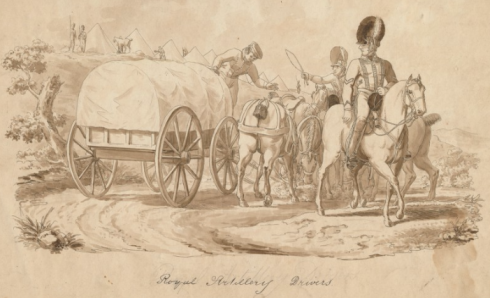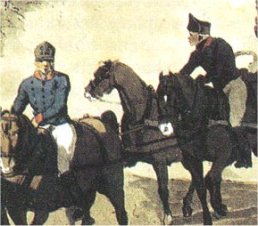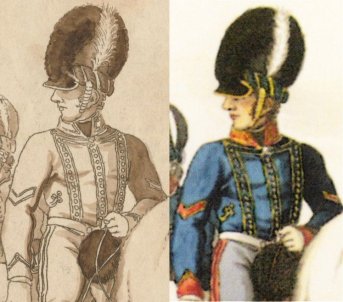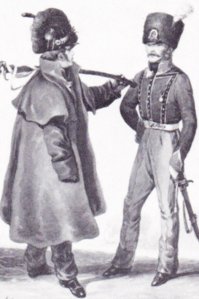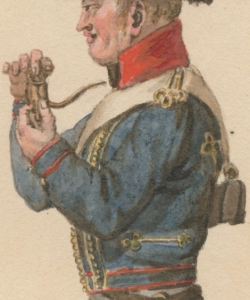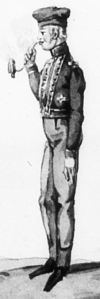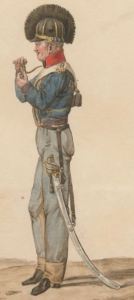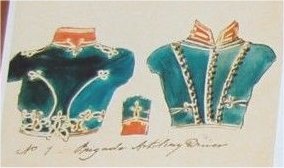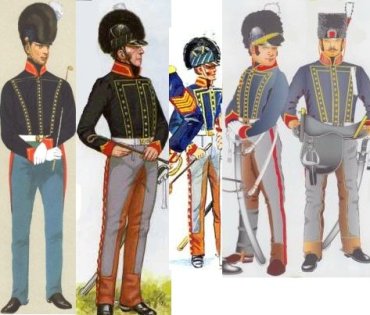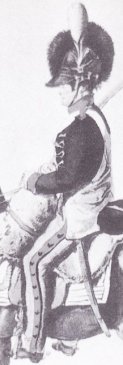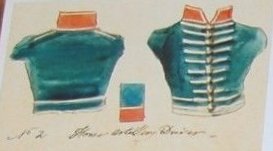(This page revised and extended October 2017)
This spin-off from my ongoing study of the King’s German Legion is an attempt to look again at the dress of that short lived and “strangely organized corps” (as one of its own officers termed it), the Royal Artillery Drivers, a topic not mentioned at all in Major Campbell’s “comprehensive account” of 1971, The Dress of the Royal Artillery. What follows is based only on the evidence known to me; more may well be hidden in the proceedings of the Board of Ordnance in WO records. The discussion here is a bit complex, so a brief summary of my conclusions is given at the end. The page has been revised once and will be revised again if and when new information arrives. Click to enlarge images.
The quaintly titled Corps of Captain Commissaries was formed in 1794 to provide drivers and teams for field guns. In 1801 it became the Corps of Gunner Drivers, and in 1806 the Royal Artillery Drivers. The functioning of the corps and its relation to other branches of the artillery were problematic. Its rank system was complex and arcane, including captains and lieutenants commissary, NCOs, rough riders, drivers and various artificers – farriers, shoeing smiths, collar makers and wheelers.
As the men of the Corps were not artillerymen and their officers drawn from outside the artillery, its divided loyalties were always a difficulty. In the Peninsula, commanders of artillery “brigades” (batteries) increasingly withdrew operational responsibility for the drivers from driver officers, giving it to their own. In May 1815 Augustus Frazer noted that at last “this necessary auxiliary … is about to be remodelled.” However, being realistic about the pace of change within the bureaucracy of the Board of Ordnance, he added: “We are always about to do something good …” Finally, in 1817 the Corps was reduced, and its officers integrated with the RA. It was disbanded in 1822 or 1824 – accounts vary.
Men of this corps were employed only with field artillery, as the drivers of the Royal Horse Artillery were enlisted in the troops with which they served, though in the Peninsular war and later, NCOs of RA Drivers were attached to troops of Horse Artillery for practical reasons. Integration of drivers as in the horse artillery was also the practice in the artillery brigades of the King’s German Legion, a factor that, in Augustus Frazer’s opinion, contributed to their “uniform good conduct”.
In 1802, according to Duncan’s history of the Royal Artillery, the Driver Corps comprised 1 Captain Commissary, 2 Lieutenants Commissary, 18 NCOs, 17 artificers and 150 drivers. By 1807 it had expanded to ten companies, and in 1810 its establishment required a Major, 2 Adjutants, 8 Veterinary Surgeonss, 11 Captains Commissary, 66 Lieutenants, 550 NCOs, 22 Rough-riders, 440 artificers, 55 trumpeters and 4950 drivers.
Regarding their clothing, Major Charles James of the Drivers, in his military compendium The Regimental Companion (several editions, 1799 to 1811), notes that:
The drivers are clothed yearly, like the artillery men, and the articles are furnished by contract with the Board of Ordnance, as are also helmets, which are supplied once in two years.
The earlier uniform
Hew Strachan’s British Military Uniforms includes a few snippets relating to the dress of the corps in the 1794-6 period, including the supply by Hawkes of Tarleton “helmet caps”. In 1798, in an estimate supplied to the Parliamentary Select Committee on Finance, William Dickey, contractor for clothing to the Board of Ordnance, lists these items for what was then termed the Corps of Captain Commissaries:
Serjeants: Coat, Waistcoat, Breeches, and Gaiters (“Leggings”), Leather Stock, Great Coat
Corporals and Artificers: Jacket, Waistcoat, Leggings, Leather Stock, Great Coat
Drivers: Jacket, Waistcoat, Leggings, Leather Stock, Great Coat, Canvas Frock and Canvas Trowsers (Stable Dress)
Dickey prices a sergeant’s coat at £3/6/4, a corporal’s jacket at £1/0/9, an artificer’s jacket at 19/6 and a driver’s at 12/9, suggesting that the corporal’s and artificer’s jackets, allowing 9d for the extra cost of a rank distinction, are the same, and more ornate than the much cheaper driver’s jacket.
The sergeant’s coat is exactly the same price as that of a RA foot artillery sergeant in Dickey’s lists. The corporal’s and artificer’s jackets are a few pence more than a Horse Artillery gunner’s dress jacket, while the driver’s jacket is the same price as the undress jacket of a Horse Artillery gunner or driver. This suggests that these may well have been essentially the patterns used for the Drivers, and the discussion below will tend to support that.
As sergeants still wore the coat at this early point, officers may well have done likewise.
A few years later, circa 1806, Charles James lists the men’s Regimentals and Necessaries as on the Return form. They include:
Regimentals
Great Coat Feather Case Boots Watering Cap
Great Coat Straps Dress Jacket Gaiters
Helmet Leather Breeches Shoes
Feather Gloves Clasps
Necessaries
Leather Stock Stockings Flannel Jacket
Stock Buckle Undress Jacket
White Shirts Overalls
Check ditto Cloth Cap
It’s useful to note that the Tarleton helmet was worn concurrently with a “watering cap” and “cloth cap”, the dress jacket with an undress and a flannel jacket, and the breeches and gaiters with overalls. The “watering cap” would have been the black leather fatigue cap described by Cavalié Mercer:
The Horse Artillery and drivers had a similar mitre-shaped cap, but better, inasmuch as, being made of thick stiff leather, it was kept polished, and looked smart. This was used for undress parades, watering order, etc.
Atkinson’s print “Artillery on a March” (1807, but maybe drawn earlier) shows this mitre-fronted cap, with the initials of the corps – “C (or G) D/R A” according to some modern interpreters. Haythornthwaite and Fosten (Wellington’s Specialist Troops, 1988) give this a peak, but in the print a cap shown in profile clearly has none.
Atkinson shows this cap worn with a short dark blue single breasted jacket without skirts, with red collar and pointed cuffs, as also worn by two background figures in Charles Hamilton Smith’s 1815 plate of “Royal Artillery Drivers”. Also helpful is the original drawing for this plate in the Anne S K Brown collection, which is clearer than the published version. One of the figures wears an undress forage cap, blue with a red band, so that this jacket has been interpreted as the undress jacket. However, since it agrees with Hamilton Smith’s later chart, we can take it as the driver’s dress jacket.
Haythornthwaite and Fosten take literally Atkinson’s rendering of this jacket with seven buttons per row, but this ignores Atkinson’s habit, for the purpose of artistic legibility, of minimising loops or buttons on smaller figures; Hamilton Smith shows twelve buttons in each row. Essentially, this appears to be an unlaced version of a cavalry jacket, and so could easily have been confused with the horse artillery when worn with the helmet.
In 1806, partly to avoid such confusion, and on the initiative of Charles James, the private’s dress jacket was modified:
“… the jackets of the privates were made with skirts and red turnbacks, in order to cover their loins, and to distinguish them from the horse artillery,” an alteration “which unites in itself the principles of distinction, as a corps, and of comfort to each individual.” For whatever reason, this feature is not visible in Atkinson’s or Hamilton Smith’s plates.
Officers
James continued to argue for changes to the dress of the higher ranks, writing in 1807:
On the uniform of the Corps of Artillery Drivers (I mean that of the officers) … The similitude which it bears to the horse brigade, or rather its identity of appearance, added to the expence, sufficiently indicates the necessity of some immediate reform.
And in a letter of 1810 to the Commissioners of Military Enquiry:
… the dress, particularly of the officers and non-commissioned, is too shewy and not sufficiently distinguished from the regular horse artillery, with which they are perpetually confounded; and it is manifest, that as serjeants from the artillery have been, and may still be, recommended for commissions in that corps, their outfit must be far beyond their means …
“Identity of appearance” suggests that officers of drivers then wore jackets entirely or largely indistinguishable from those of the Horse Artillery. Next to no evidence seems to survive, but an account in the tailor’s ledger of Jonathan Meyer for Captain Commissary Frederick Rehwinkel of the King’s German Legion, as detailed on page 13 of my KGL study, includes an entry of 1810 for lengthening a uniform jacket. This clearly indicates a jacket with three rows of ball buttons with gold braid loops, and apparently with ornamentation in gold figuring braid on the back, which suggests the RHA pattern.
Ten months later, in July 1811, Rehwinkel had a new jacket made by Meyer, the pattern noted as “Gunner Drivers”, and at a substantially lower price than that of an RHA jacket. Due to some misunderstanding over the pattern the new jacket had to be altered before delivery, which involved “adding another row of French braid round the same [i.e. the jacket],” using 3⅝ yards of gold braid, and changing the collar. The phrase “round the jacket” suggests to me that the gold braid may have been applied in a frame around the buttons, as on the NCO’s and artificer’s jackets discussed below. Rehwinkel’s jacket also included a pair of gilt chain wings – another point of difference to the horse artillery.
 (Rehwinkel was not commissioned to the Corps of Drivers but to the KGL; however, as officers of KGL artillery followed the directions of the Board of Ordnance in their dress, we can assume a similarity here. Details of Rehwinkel’s waistcoat, pantaloons and greatcoat can be found on page 13 of my KGL study. Thanks to Meyer & Mortimer and Ben Townsend for access to this source.)
(Rehwinkel was not commissioned to the Corps of Drivers but to the KGL; however, as officers of KGL artillery followed the directions of the Board of Ordnance in their dress, we can assume a similarity here. Details of Rehwinkel’s waistcoat, pantaloons and greatcoat can be found on page 13 of my KGL study. Thanks to Meyer & Mortimer and Ben Townsend for access to this source.)
At a later date, there appears to have been no distinction between the dress of officers of Drivers and of Horse Artillery; Marcuard’s charts of 1819 show this clearly. (The version shown here at right is a copy by John Mollo from the Anne S K Brown collection.)
The later uniform: NCOs and artificers
Charles James’s comment that the uniform of driver NCOs was distinct from that of privates, and “shewy” into the bargain, supports my earlier speculation that in the earlier period NCOs and artificers of Drivers wore jackets similar to a Horse Artillery gunner’s dress jacket. But at some point before 1815, this was changed for a distinctive jacket with a braid “frame” around the buttons. (If a parallel alteration to officers’ jackets was made in 1811, as I’ve speculated regarding Rehwinkel, the change to these jackets might also have been ordered that year.)
Four contemporary images show versions of this jacket. Charles Hamilton Smith’s 1815 plate of “Royal Artillery Drivers” and its preparatory drawing show what appears to be a second corporal, with a single chevron, in a cavalry style jacket with three rows of perhaps 16 buttons. These rows are edged in a yellow cord or braid which also links the top buttons to form a frame. Collar, cuffs and chevron are red, edged with yellow cord or braid, with eyes at the front corners of the collar and an eye in the cuff – whether above or below the point is not clear. The cord or braid forms an eye at each top corner of the frame, and the pocket is edged in the same with a crow’s foot at the end. The details of the lower edge of the jacket are masked in the image by a white sword belt.
Grey overalls are worn with a double red stripe but with no strapping or cuffs; the helmet has a white plume and blue turban, which agrees with other sources.
A watercolour in the Royal collection by Alexander Sauerweid, dated to circa 1816, shows a private and farrier. The former wears the helmet as known, with a grey great coat. The farrier’s jacket is similar to Hamilton Smith’s version, though the yellow trim looks closer to the edge of the collar and cuffs, the cuff point has no eye, and the buttons seem fewer. His overalls match the Smith image, but with tan leather strapping and cuffs. The cap is brown fur with a white horseshoe. (Miller and Dawnay’s notes to their black and white reproduction of the painting give the braid as gold, but this seems unlikely, and we should understand it as yellow.)
The Sauerweid painting very clearly gives the ground of the jacket frame, within the lines of braid, as a darker blue. At first glance, this seems true of the Hamilton Smith corporal too, but on closer examination this is accidental, the larger part of the frame lying within areas of shadow that show darker. This may well be evidence that Sauerweid used Hamilton Smith as a partial source in this case, and interpreted this feature wrongly. (Miller and Dawnay allege that Sauerweid’s British subjects are cribbed from Hamilton Smith.)
The third relevant image is a small watercolour figure circa 1815 (of an artificer?) by Noël-Dieudonné Finart, in the Royal collection and inaccurately titled “Canonnier Anglais en négligé”. (Thanks to Ben Townsend for a view of a colour photo of this.) The same jacket is shown, though with round cuffs. The top of the yellow lace frame is not evident here, though the image suggests that it may also have run around the lower edge of the jacket, a feature masked by belts in the other two versions. The ground within the frame here is clearly the same colour as the jacket. A shoulder strap with a trefoil end, as on the pocket, is also indicated. The red collar is edged in yellow top and front, and the cuffs on the top edge. The grey overalls are strapped and cuffed in brown leather but without stripes, and the undress cap is as in the Smith plate, blue with a red band. The small size of the image, though it is deftly painted, makes some of the detail unclear, but it is still of much interest.
A larger watercolour by Finart (above centre and right), which has the look of having been worked up from the previous image, is in the Anne S K Brown collection, and is titled simply “Canonnier Anglais”(below left). Here the Tarleton is worn, though the blue turban is meanly rendered – almost invisible in fact – and the feather missing. Details of the jacket are much sharper here, including ornamentation on the rear seams, but there are worrying differences – no collar trim, blue cuffs edged in red, and red edging to the band around the waist. A sabre is worn.
A watercolour of a date and origin not known to me shows a jacket compatible with these images, front and rear, captioned “No 1 – Brigade Artillery Driver”. (The handwriting bears a passing resemblance to that of Percy Sumner, but the drawing seems less crisp than his usual style, and I can’t honestly say that this is from Sumner’s notes. The photo forms part of a folder of uniform material recently offered online, in which sources are not noted. Apologies for the small image here.)
The style is more ornate than what we have seen so far, with the bottom edge braided, a collar loop ending in a crow’s foot, a crow’s foot and eyes at the rear of the collar, and, interestingly, a knot on each shoulder that seems to be what is shown by Finart. The cuff has a crow’s foot with three eyes, up and down, in the line below. The rear is more ornate than we might expect, in horse artillery style. If the braid here were intended as gold, we could take this as an officer’s jacket, except for the shoulder knot in place of gilt chain wings. If the image is accurate, this must be an NCO’s or artificer’s jacket, the additional detailing a sign of rank or of a slightly later date.
A number of modern illustrators have tackled a figure in a version of this jacket – Smitherman, the Fostens, Lordey and Franklin come to mind. The numbers of buttons they choose to show seems pretty arbitrary. Their versions don’t take account of the Finart image, nor of the “mystery” watercolour.
Ironically, the much urged adoption of a distinctive pattern of dress was later seen as an insult to the Drivers; by the war’s end Augustus Frazer (Remarks on the Organization of the Corps of Artillery in the British Service, 1818) was arguing for a common style:
The difference of the uniform of the Horse Artillery Drivers, and those of the rest of the service, may appear but a trifling consideration; but the Drivers want encouragement, and every thing should be attended to which tends to do away useless distinction.
Side arms
Despite images, contemporary and modern, that might seem to prove otherwise, it’s clear that only officers and NCOs of the RA drivers were armed. James protests:
We cannot help remarking that, contrary to every military principle, and in direct contradiction to the usage in continental armies, the privates of the corps of royal artillery drivers are not furnished with any offensive or defensive weapon. They might, surely, have a short sword and a brace of pistols.
Augustus Frazer later confirms this:
… the employment of the Drivers … calls for the highest exercise of courage, since these men are unarmed, and passive spectators of the dangers of war.
The Vernet problem
One problem remains. An image by Carle Vernet, dated to 1815-16, and said to be of a mounted driver, shows a jacket with plain red collar, cuffs and shoulder strap, but with what appear to be bastion pointed yellow loops on the front as on the RA foot artillery jacket. The bottom edge and skirts of the jacket are covered by a haversack. This is worn with the helmet and grey overalls with a red stripe and metal buttons. Worryingly, given the documentation above on unarmed drivers, he carries a sabre. The details here are puzzling, and I’m not aware of any supporting evidence, but this hasn’t deterred some modern illustrators from showing such a jacket in wear with additional details including skirts and loops on the collar and cuffs.
Philip Haythornthwaite suggests, logically enough, that this jacket may have been worn by drivers attached to the foot artillery, and the other styles worn by those with the horse artillery, but since the Corps of Drivers served only with the former, this doesn’t quite make sense. It could be that Vernet’s image is simply faulty, but another explanation is possible.
The 1798 estimates by artillery clothier William Dickey, cited above, show that a Horse Artillery driver’s dress jacket, then priced at 14/2d, must have been noticeably less ornate than those of a gunner or bombardier, at 19 shillings and 24/1d respectively, and it seems likely that this distinction was maintained.
As a possible confirmation of this, the “mystery” watercolour discussed above is accompanied by an image of a second jacket, captioned “No 2 Horse Artillery Driver”, which shows a relatively simple style, compatible with Vernet’s image, except for the ten square ended loops, rather than bastion, and the edging to the collar, shoulder straps and cuffs. The double line of braid around the lower edge is interesting.
I’d suggest that Vernet’s image may represent a Horse Artillery driver, rather than a members of the Corps of RA Drivers. Duncan notes that Horse Artillery drivers’ jacket were not assimilated to those of the gunners until 1831.
A tentative summary
- Helmet with white plume and blue turban, black leather watering cap, undress cap
Earlier uniform – to 1811?
- Officers (to circa 1798): coat. Subsequently, jacket, RHA pattern or similar
- Sergeants (to circa 1798): coat, RA sergeant’s pattern or similar
- NCOs and artificers: jacket, RHA gunner’s dress jacket pattern or similar
- Drivers: dark blue jacket, three rows of buttons, red collar and cuffs, RHA gunner’s undress jacket pattern or similar. From 1806 with skirts and red turnbacks
Later uniform – from 1811?
- Officers: jacket with gold braid, probably in a frame, gilt chain wings
- NCOs and artificers: dark blue jacket, red collar and cuffs with yellow trim, three rows of buttons in a frame edged in yellow
- Drivers: as earlier uniform
- Overalls as noted

